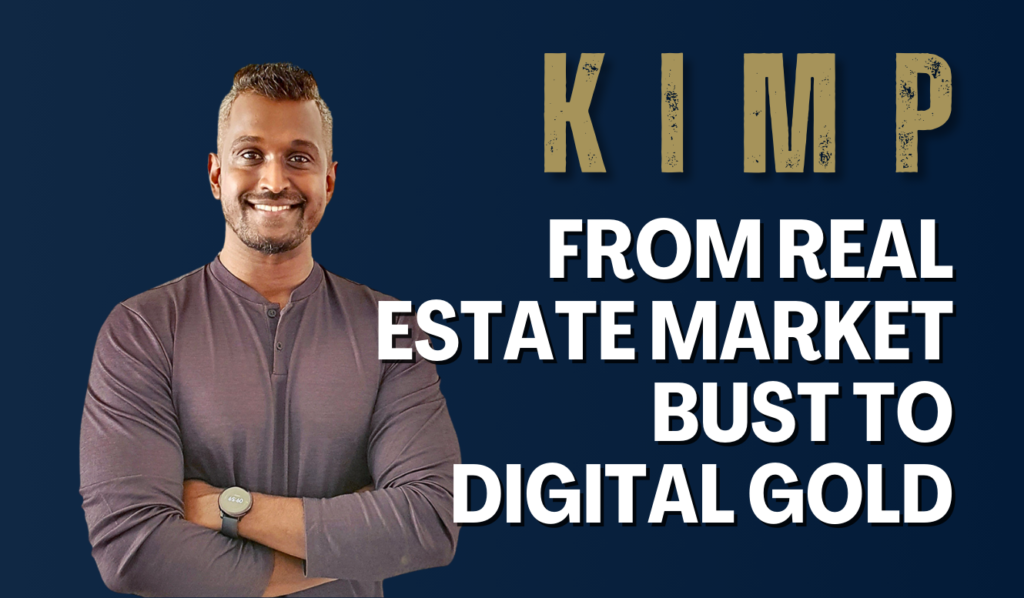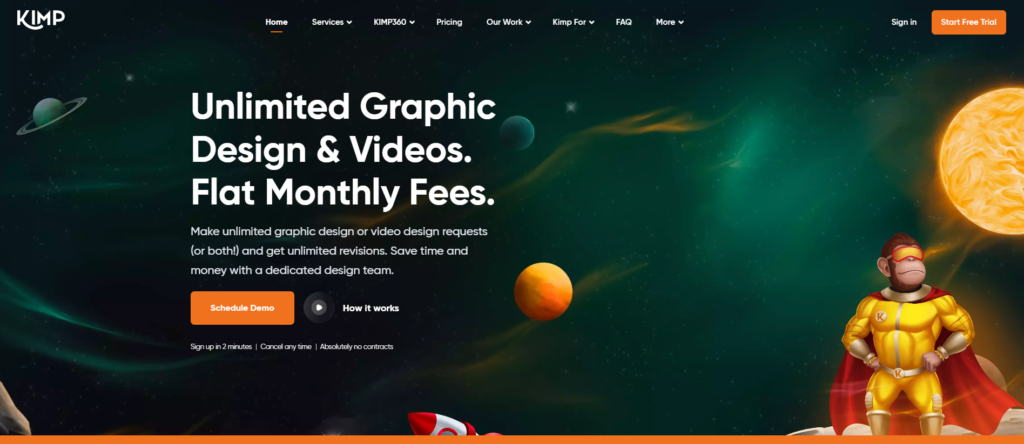
Who are you and what is your background?
My name is Senthu Velnayagam and I’m a serial entrepreneur and tech and real estate investor. Over the past 20 years, I’ve focused primarily on building and scaling businesses in the realm of design and marketing. My current project is KIMP – it’s the culmination of those businesses and all the lessons learned along the way.
What is your business and when did you start it?
KIMP is a subscription-based design service, delivered through a custom-built project management software (KIMP360). Our focus at KIMP is to deliver in an efficient, reliable, and cost-effective manner in which to complete design projects. Through our flat-fee, month-to-month design subscriptions we offer our clients unparalleled flexibility and savings.
Our clients, from around the world, collaborate remotely with their assigned design team, via KIMP360. The software ensures that they have both a bird’s eye view and a detailed view of all of their design projects within KIMP. It also allows them to make and manage their design projects, invite collaborators to help with their workflow, and access their design files.
We offer subscriptions ranging from graphic and video design to Canva designs. Our graphic design subscriptions include print and digital creatives, custom illustrations, UI design, and Canva designs. Our video subscriptions include animation, motion graphics, and video editing. Our Canva subscriptions meanwhile offer an exclusive focus on designs created in Canva, ranging from graphics to animations.
What was your professional situation right before starting the agency?
Prior to launching KIMP, I was managing a marketing and design agency. Our clients were primarily in the real estate and development industries. After many years of success with the model, we were met with changing market conditions, and our clients reducing their marketing and overall operations expenditures as a result.
A fatal flaw of the design agency model is the precarious situation you can often find yourself in, owing to the dependency on a few clients for the bulk of your business. If those clients shift their budgets or experience downturns, the ripple effect is inevitable.
As the real estate market hit a slump, we were forced to pivot quickly. We tried a few different models, and eventually returned to one we’d first considered in 2015 – subscription-based design services. We studied what others in the industry were doing, and crafted our version of the model, including enhancements we felt could improve the user experience. 5 years later, here we are, continuing to deepen our footprint in this space.
How did you get the idea to start this particular business?
Having worked in design and marketing for around 16 years at the time, I was always keen to explore new business models through which to deliver creatives to clients. So unlimited graphic design services were on my radar from around 2015 as more and more players in that space were emerging.
At the same time, as we were undergoing a pivot from a design agency, I was looking for business models that would allow our talented team to continue to work together. Ultimately, unlimited design services emerged as the best approach to direct our pivot.
What was the major challenge you faced in starting or scaling it and how did you overcome it?
A major challenge that was faced in starting KIMP was that we had a lot of overhead costs from the get-go, as we already had a large team. Since we were launching with a pivot, we didn’t have the opportunity to keep our expenses lower initially. And we had to find ways to generate revenue quickly enough to reinvest into KIMP. Ultimately we were able to stretch ourselves thin enough to make things work until we started getting traction for KIMP. But it was quite the hurdle to have those bills looming over us, and knowing that it was all or nothing.
When it came to customer acquisition and scaling, we had to work very hard to ensure we built credibility. It’s a crowded industry with many competitors who had landed on the scene well before us. When doing a side-by-side comparison, it was a tough sell to convince clients to choose us when we didn’t have many reviews or other social proof to demonstrate the value we could provide. At first, we even offered a two-week free trial to gain clients’ trust. We also performed outreach to past clients from our agency to get the word out and see if we could drum up some customers. It took us a while, but eventually, we were able to create enough testimonials, reviews, and case studies to acquire customers with more ease.

What was growth like over the first couple of years?
In the first couple years, growth was steady in terms of client acquisition and subsequent revenue from social media ads, however, we did experience fluctuations after an initial uptick. Growth was much slower and steadier when it came to web traffic. As our content accumulated over time, we started to see an uptick in site traffic as well. This was from a combination of content we were publishing directly on our site and backlinks and guest blogging.
What was your specific strategy for growing it and how did you implement that?
Our strategy for growth has been a combination of content marketing, paid ads, and sales outreach. For social media ads, my strategy was to A/B test a mix of ad types that took reference from the most creative ads we found that were targeting similar audiences. The Facebook ad library has been a very helpful tool to this end, allowing us to see what types of ads brands are running at any given time and the types of copy they are utilizing. We mixed and matched various elements until we found combinations that resonated with our target audience. As we collected more reviews and testimonials over time, we were able to incorporate social proof into our ads as well.
With regard to our content strategy, we created blogs that covered a combination of topics that would resonate with different segments of our target audience. For the specific topics and keywords, we took reference from high-performing pieces of content ranking for the keywords our audiences were searching for. We also sought out opportunities to post guest blogs and to be featured on review sites and directories to help access new audiences.
For our outbound sales strategy, I got inspiration from how SAAS companies reached out to me over time. We pooled together what we felt were the most memorable approaches and then crafted email and call scripts from there. To populate leads to reach out to, we targeted companies and entrepreneurs from industries that we thought would be a good fit for our services and reached out via email, LinkedIn, and calling campaigns.
How much money is the business making now and what is the revenue mix?
KIMP has fortunately been able to increase our client base, and revenue, year-over-year. We were generating a comfortable profit by year 2. Our revenue mix comes from a combination of subscribers for our 5 subscriptions (KIMP Graphics – $599, KIMP Video – $699, KIMP Graphics+Video – $995, Canva Graphics – $499, and Canva Plus – $799). Our subscriptions, in turn, are divided into: month-to-month subscriptions, and our longer-term subscriptions (3, 6, and 12 months). Our longer-term subscriptions include varying discounts to serve as an incentive to sign up for longer durations.
Another revenue-stream, related to our subscriptions, is our pause fee. For clients who don’t have ongoing design needs but would like to retain access to their assigned design team and the KIMP360 platform to access design files, we offer the ability to pause with a nominal monthly fee.
By offering different subscriptions, at various price points, we can serve clients across industries and around the world.
If you were advising someone on starting a similar company today, what would you tell them is the key area to focus on and which strategy should they use to address it?
If I were advising someone starting a similar company today, I would tell them to focus on identifying how they can scale their minimal viable product (MVP) without compromising on quality. When productizing a service, the degree to which you can standardize that service, and offer it without fail is a top priority. This will impact everything from customer acquisition and retention, to being able to secure reviews, testimonials, and case studies (social proof).
All of the seemingly small processes, and checks and balances that can be put into place to ensure consistency will go a very long way. At KIMP this has meant everything from using time-tracking tools to understand how we are allocating our time across different tasks, to implementing SOPs for each stage of the client journey, to asking our clients to participate in onboarding questionnaires, calls, and check-in calls to gather and implement their feedback.
What’s next for you?
At KIMP we’re currently working on, and looking ahead to, more ways we can incorporate AI into our workflows to create additional value for clients, and efficiency amongst our design teams. In the past year or so we’ve seen so many new tools rolled out, and it’s exciting to think that we’re still just in the early stages of how AI can help us automate repetitive tasks and iterate creatives more efficiently.
From being able to generate stock images and visual references for design projects (coming soon) to voiceovers (currently live in KIMP360), animations, and more we want to empower our clients to be able to request design projects with more precision. And more than that, we want to push the boundaries of their creativity and our own, with the help of AI.

